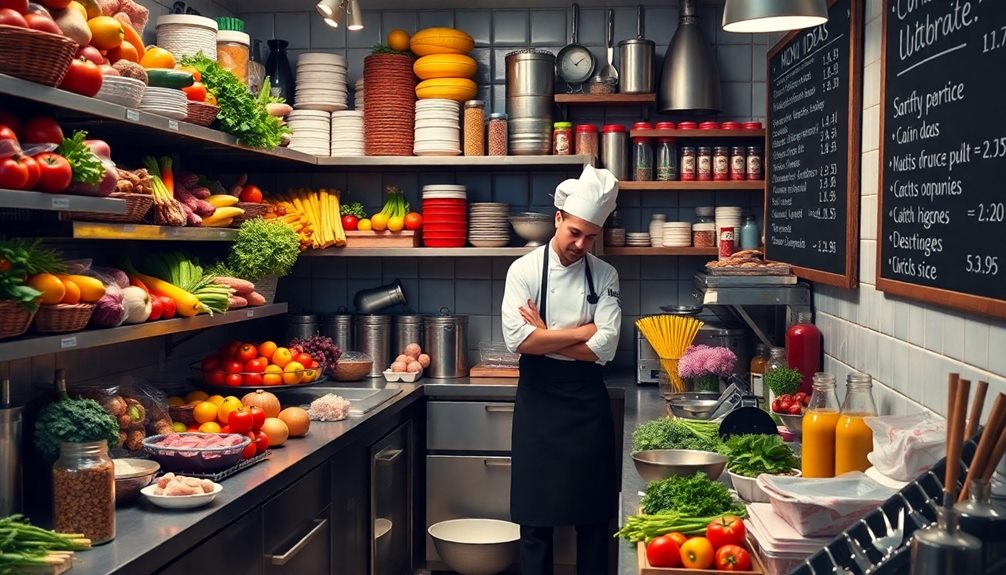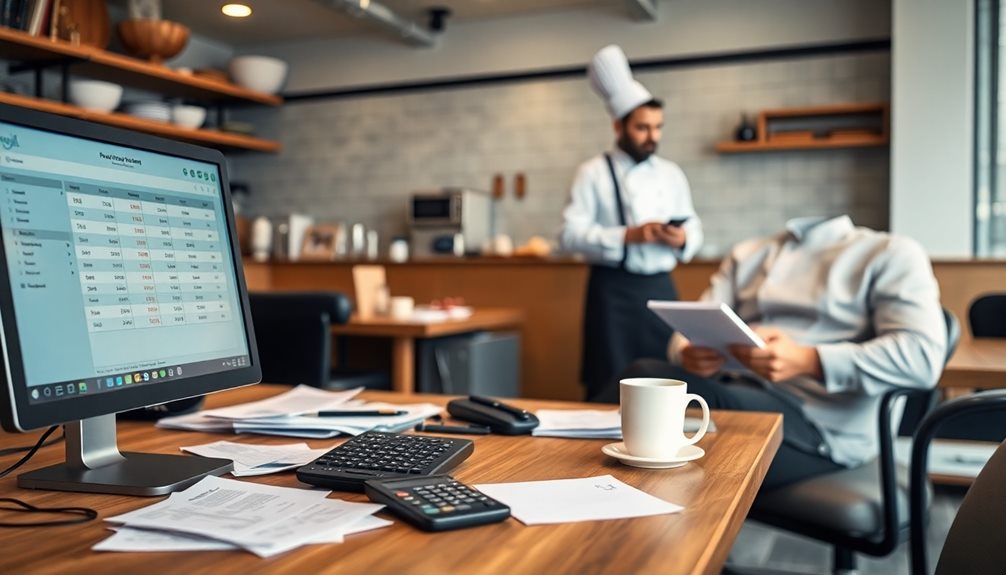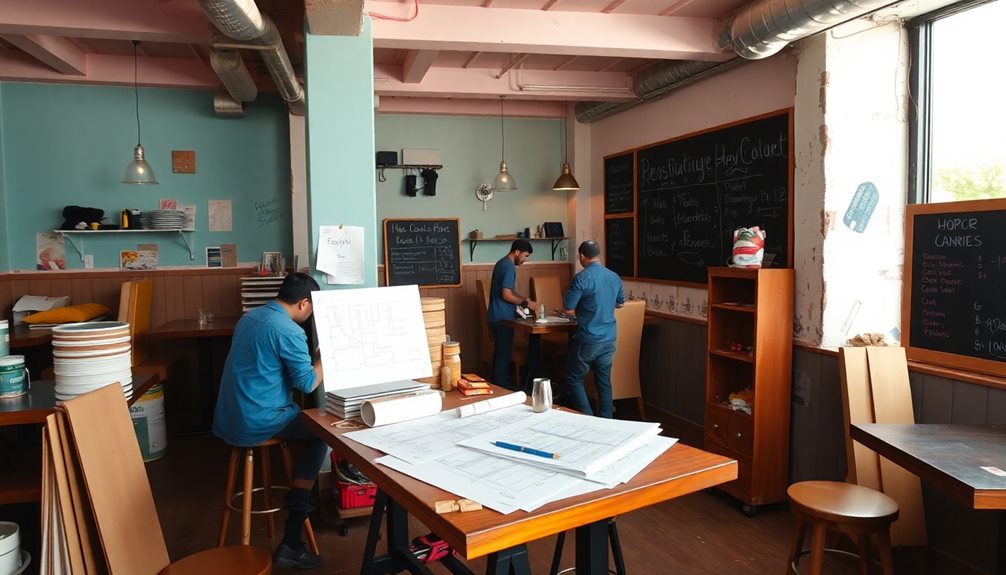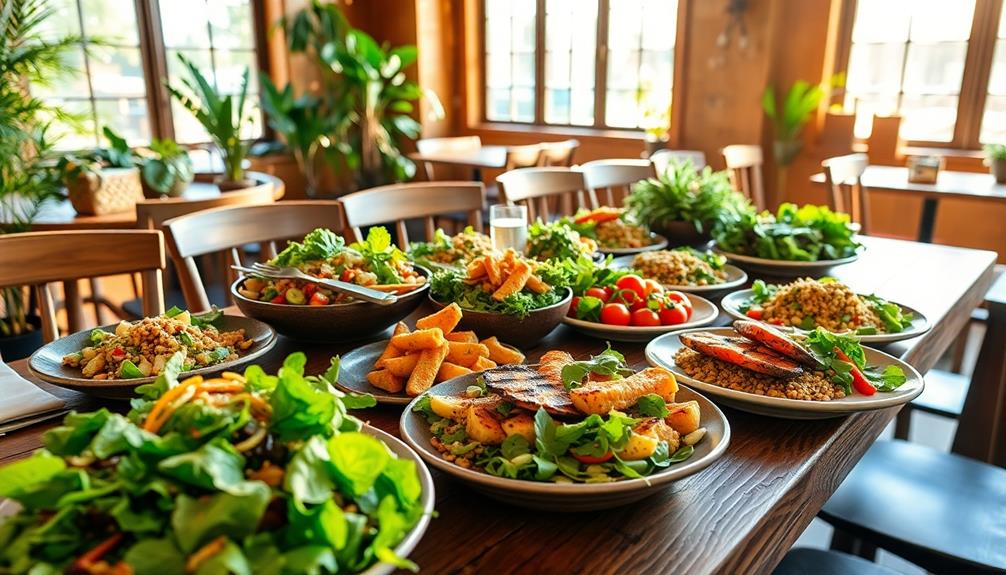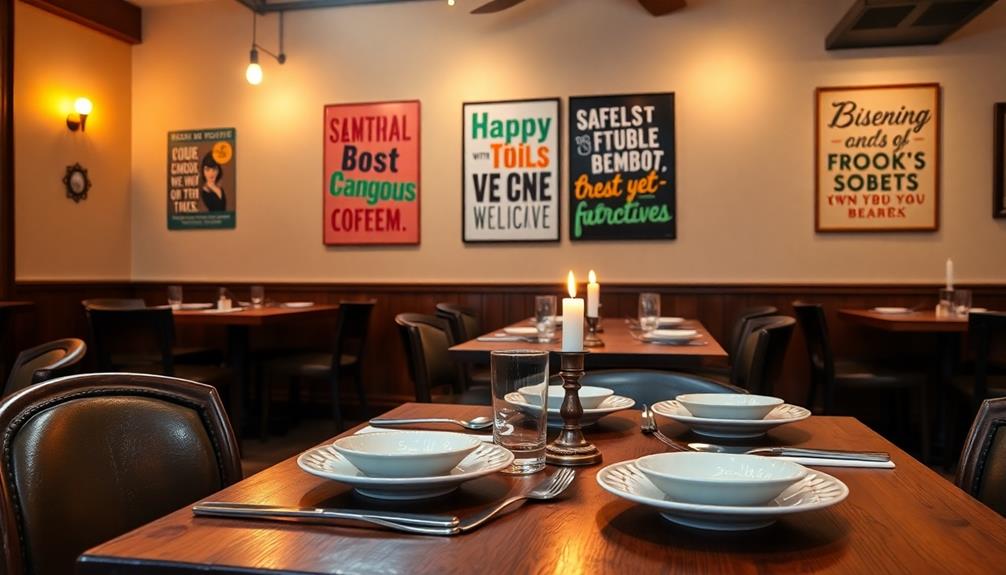To manage your restaurant's cash flow effectively, start by understanding your cash inflows and outflows. Keep track of your operating expenses and forecast future cash needs using historical sales data. Regularly review your fixed and variable costs, seeking areas for savings, like negotiating lease terms or optimizing labor. Implement efficient inventory management practices to reduce waste, and consider promoting unique events to boost revenue. Finally, set aside a portion of profits for cash reserves to create a financial cushion. There's plenty more to explore on how to enhance your cash flow strategies.
Key Takeaways
- Regularly forecast cash flow using historical sales data to predict inflows and manage financial obligations effectively.
- Monitor and negotiate fixed costs, like leases and energy expenses, to improve cash flow.
- Optimize labor expenses by forecasting staffing needs and implementing flexible scheduling based on sales trends.
- Conduct inventory audits and utilize cross-utilization of ingredients to minimize waste and manage stock efficiently.
- Diversify revenue streams through unique events and promotions to attract customers and boost sales during off-peak hours.
Understanding Cash Flow Basics

Understanding cash flow basics is vital for any restaurant owner. Cash flow is all about the net amount of cash moving in and out of your business. Your cash inflows primarily come from customer payments, while cash outflows relate to your operating expenses, like wages and utilities. Keeping a close eye on these aspects helps prevent cash flow problems that can jeopardize your restaurant's financial health.
To effectively manage your cash flow, you need to monitor your operating cash flow. This measures the cash generated from your daily operations and highlights how well your restaurant can cover its expenses. A cash flow statement is a valuable tool that records your cash inflows and outflows over a specific period. It allows you to assess your cash availability for operational needs and potential investments.
Understanding the difference between fixed costs, such as rent and insurance, and variable costs, such as food and labor, is essential. Fixed costs remain constant, while variable costs fluctuate with sales.
Regularly reviewing your cash flow statements helps you identify trends and discrepancies, empowering you to make informed financial decisions that keep your restaurant running smoothly.
Importance of Cash Flow Forecasting
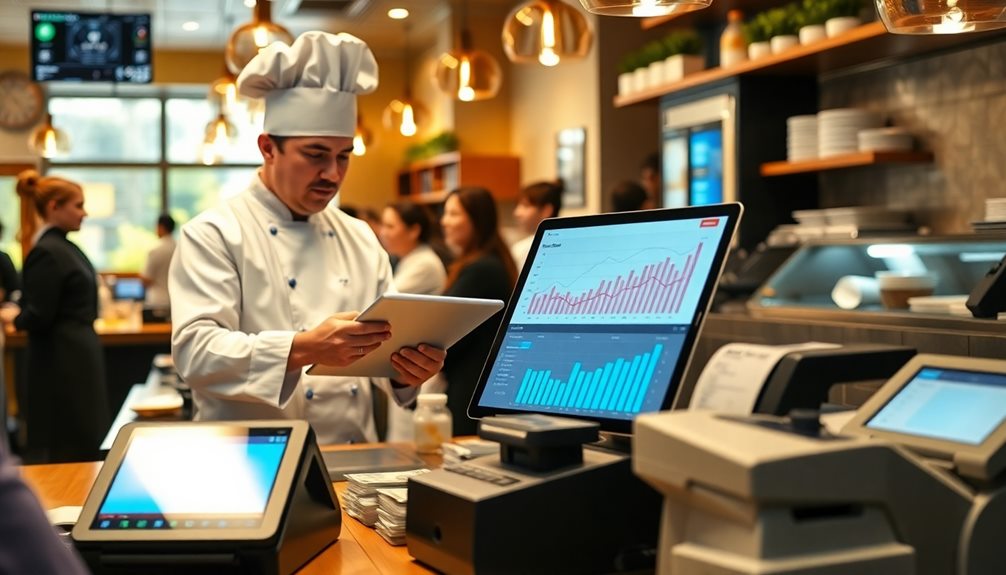
While cash flow forecasting might seem intimidating at first, it's an essential tool that can greatly influence your restaurant's financial health. By utilizing historical sales data, you can predict future cash inflows, enabling you to anticipate slower business periods and adjust your operational strategies accordingly.
Accurate cash flow projections help you identify upcoming bills and financial obligations, allowing for timely investments in marketing and equipment that can enhance your revenue potential.
Implementing a cash flow forecasting model also aids in managing seasonal fluctuations, ensuring your budgets align with expected sales patterns and staffing needs. Regularly reviewing these forecasts empowers you to make informed financial decisions, such as when to cut costs or increase inventory, ultimately supporting sustainable profitability.
Leveraging tools like cash flow calculators can considerably improve your forecast accuracy, helping you prepare for unexpected expenditures and maintain financial stability during downturns.
For restaurant owners, mastering cash flow forecasting isn't just about keeping the lights on; it's about positioning your restaurant for growth and resilience in a competitive market. Embrace this practice to secure your establishment's future and enhance overall financial health.
Strategies for Managing Expenses
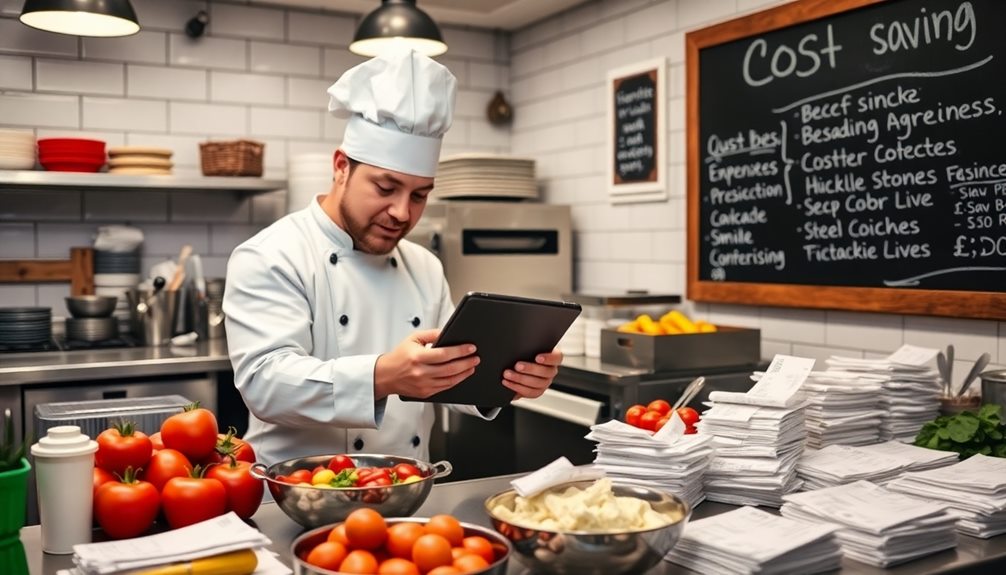
To effectively manage your restaurant's expenses, you need to keep a close eye on your fixed costs, optimize labor expenses, and control inventory waste.
By monitoring these key areas, you can make informed decisions that directly impact your cash flow.
Implementing these strategies will help you maintain a healthier bottom line and improve overall financial stability.
Monitor Fixed Costs
A considerable portion of your restaurant's expenses comes from fixed costs, which often account for 30% to 50% of your overall budget. To improve cash flow, you need to regularly review these costs.
Start by evaluating your rent and utility bills. Negotiate lease terms with your landlord; even a 10% reduction in rent can notably enhance your cash flow.
Implement energy-saving measures, like using energy-efficient appliances and adjusting heating and cooling systems. You could save up to 20% on energy costs, which adds up over time.
Also, conduct periodic evaluations of fixed expenses to identify areas where you can cut costs. For example, consider consolidating insurance policies to take advantage of multi-policy discounts.
Establish a budget for your fixed costs based on historical financial data. This will help you forecast and manage your cash flow during low-revenue periods.
By keeping a close eye on fixed costs and making adjustments where necessary, you can free up resources to better support your restaurant's growth and stability.
These cash flow management tips will help you maintain control over your expenses and guarantee your restaurant thrives.
Optimize Labor Expenses
Managing fixed costs is just one piece of the puzzle; optimizing labor expenses is equally important for maintaining a healthy cash flow. Labor costs can account for 20% to 30% of your total restaurant expenses, so it's vital to forecast daily employee needs based on historical sales data. This will help you determine the right staffing levels for busy and slow periods.
Consider implementing flexible staffing models. Hiring temporary staff during peak times and reducing hours during slow periods can greatly help manage labor costs.
Regularly evaluate employee schedules against actual sales to better align your labor needs and cut unnecessary payroll expenses.
Utilizing technology for scheduling can also enhance labor efficiency. This allows you to adjust shifts in real-time based on changing customer demand.
Additionally, conducting thorough training for your staff on efficient service practices can minimize labor costs while boosting customer satisfaction and overall productivity.
Control Inventory Waste
Controlling inventory waste is essential for maintaining a healthy cash flow in your restaurant. By implementing effective inventory management strategies, you can reduce food costs and enhance profitability. Here are some practical steps to reflect upon:
| Strategy | Benefits |
|---|---|
| Regular Inventory Audits | Identify slow-moving items to adjust stock levels, reducing waste. |
| Cross-Utilization of Ingredients | Minimize excess inventory and spoilage by using shared ingredients across menu items. |
| Staff Training on Portion Control | Teach proper measurement techniques to greatly cut food waste, which can account for 4-10% of costs. |
| Utilize Inventory Management Systems | Track stock in real-time, forecast needs accurately, and avoid over-ordering. |
| Careful Forecasting & Menu Adjustments | Adapt your menu based on ingredient availability and seasonal trends for efficient inventory management. |
Effective Inventory Management
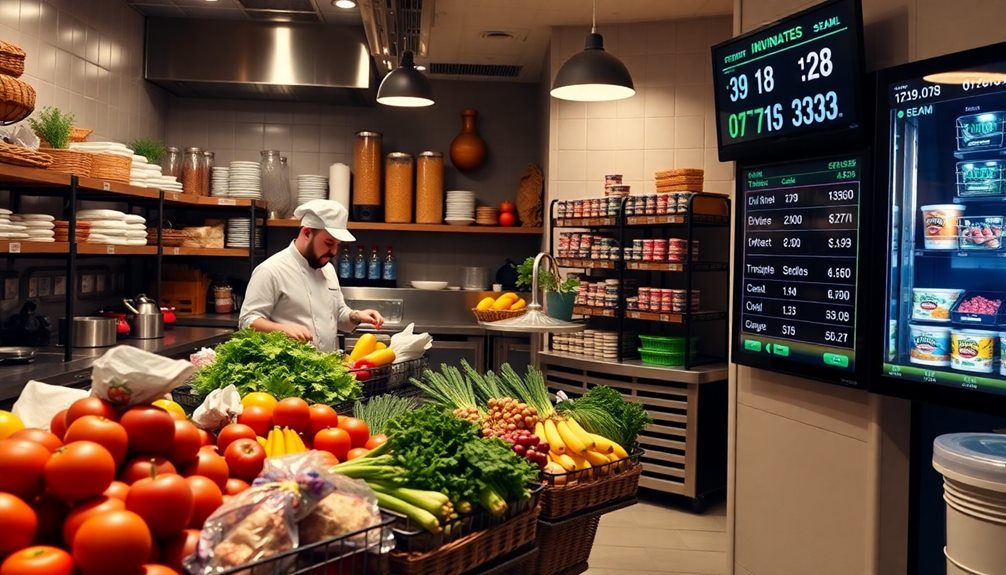
To keep your restaurant's cash flow healthy, regular inventory checks are vital.
Training your staff on effective inventory practices guarantees everyone's on the same page, minimizing errors and waste.
Exploring alternative vendors can also help you find better deals, freeing up more cash for other essential expenses.
Regular Inventory Checks
Regular inventory checks are essential for maintaining a healthy cash flow in your restaurant. By conducting these checks regularly, you can identify overstocked items and slow-moving products, preventing cash flow issues and minimizing food waste.
Implementing an effective inventory management system not only improves order accuracy but also streamlines your processes, guaranteeing your stock levels align with sales trends.
Consider minimizing menu options to decrease the amount of inventory you need. This approach allows for more efficient use of ingredients and reduces the risk of spoilage.
Additionally, cross-utilizing menu items can further help manage your inventory effectively. By using the same ingredients across multiple dishes, you can enhance your menu while keeping costs in check.
Regular inventory audits also reveal discrepancies that might otherwise go unnoticed. By catching these issues early, you can make timely adjustments to your purchasing strategies, leading to improved cash flow management.
Remember, maintaining regular payments for your inventory purchases can help you stay on top of your financial health.
Adopting these practices will guarantee that your restaurant operates smoothly and profitably, keeping food waste at bay.
Staff Training Techniques
Proper staff training techniques are essential for effective inventory management in your restaurant. Implementing regular training on measurement techniques can greatly reduce food waste, which could account for up to 10% of your total inventory costs. Cross-utilizing ingredients across menu items also minimizes inventory levels while maximizing resource use, reducing spoilage.
Consider incorporating the following table to help your staff understand key training areas:
| Training Focus | Benefits | Cash Flow Impact |
|---|---|---|
| Measurement Techniques | Reduces food waste | Lowers inventory costs |
| Cross-utilization | Maximizes ingredient use | Minimizes spoilage |
| Inventory Audits | Identifies slow movers | Streamlines reordering |
| Overstock Reporting | Prevents cash flow issues | Reduces holding costs |
Training your staff to recognize overstocked items enables timely reordering, further enhancing cash flow. Utilizing inventory management software provides real-time insights into stock levels and sales patterns, empowering your team to make informed decisions. By investing in staff training, you'll create a more efficient inventory management system that stabilizes your restaurant's cash flow.
Alternative Vendor Exploration
Exploring alternative vendors can greatly enhance your restaurant's inventory management and cash flow. By regularly comparing prices from multiple suppliers, you could save up to 20% on costs, noticeably improving your cash flow management. This is vital, especially during peak seasons when ingredient demand drives prices higher.
Implementing a diversified supplier strategy not only secures better pricing but also minimizes risks associated with supply chain disruptions, which aligns with the strategy of diversification to reduce risk in investments. This guarantees you maintain consistent inventory availability, which can prevent stockouts and lost sales.
Conducting thorough vendor performance reviews is essential. By identifying underperforming suppliers, you can negotiate better contracts or switch providers to uphold quality and cost efficiency.
Additionally, utilizing technology for inventory management can streamline evaluating vendor options and tracking inventory levels. This approach reduces food waste and optimizes cash flow, allowing you to make informed decisions based on real-time data.
Incorporating these strategies into your operations will empower you to make smarter purchasing decisions, ultimately enhancing your restaurant's overall financial health. So, don't hesitate to explore alternative vendors and elevate your inventory management practices.
Optimizing Revenue Streams
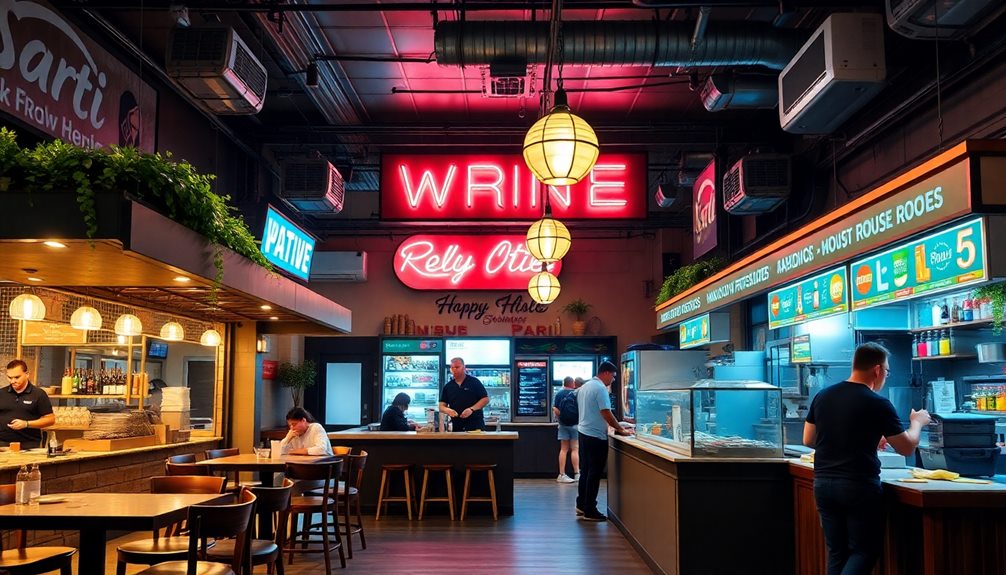
How can you effectively boost your restaurant's cash flow? One key strategy is optimizing revenue streams.
Start by hosting unique events like wine tastings or themed dinners. These can attract new customers and diversify your offerings, especially during slower periods, which can increase cash flow.
Additionally, consider implementing a deposit requirement for private bookings. This not only secures cash flow but also reduces the risk tied to cancellations.
Don't underestimate the power of promotions. Offering early bird specials or limited-time deals encourages customers to dine out during off-peak hours, helping to boost overall sales.
Another effective approach is utilizing email marketing campaigns to communicate exclusive offers and events. This enhances customer engagement and strengthens repeat business, contributing to steady revenue.
Building Cash Reserves
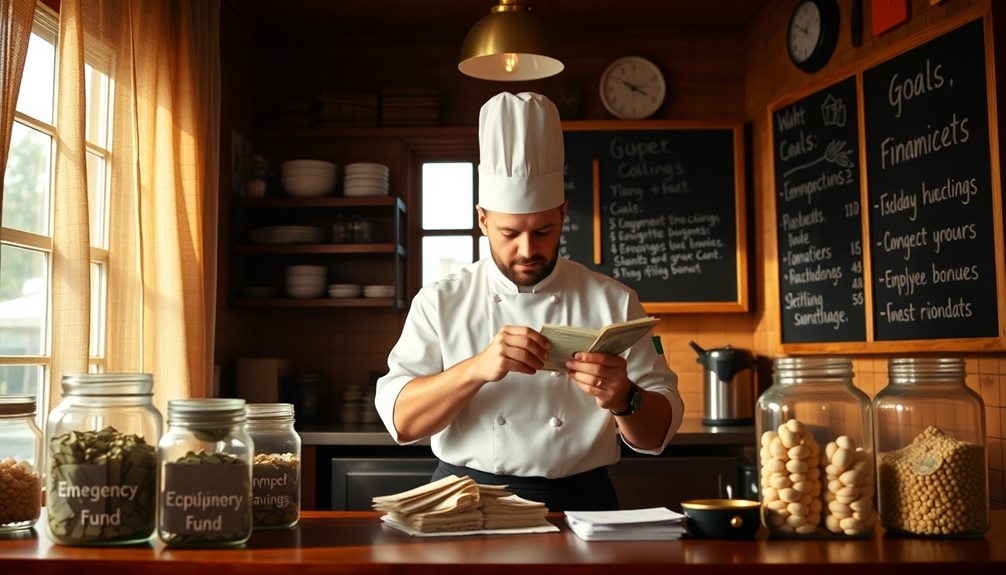
Building cash reserves is essential for any restaurant looking to weather financial storms and seize new opportunities. By establishing a solid foundation of cash reserves, you enhance your cash flow management and guarantee better financial stability.
Here are some effective strategies to build those reserves:
- Set Aside Profits: Aim to allocate at least 20% of profits during peak periods to create a financial cushion for slower times and unexpected expenses.
- Dedicated Savings Account: Create a separate savings account for your cash reserves. This makes tracking and accessing funds easier, guaranteeing operational cash flow isn't disrupted.
- Review Cash Flow Statements: Regularly analyze your cash flow statements to spot revenue and expense trends. This helps you adjust your savings strategies according to predicted slow periods.
- Implement a Budgeting System: Design a budgeting system that allocates a portion of sales specifically for cash reserves. This practice maintains financial stability and lessens reliance on credit during tough times.
Frequently Asked Questions
What Is the Cash Flow of a Restaurant?
Cash flow for your restaurant is the net cash moving in and out, driven by customer payments and expenses. It's essential for covering costs and ensuring you have enough liquidity for growth and operations.
How Do You Manage Cash Flow Effectively?
To manage cash flow effectively, regularly monitor your cash flow statements, create forecasts based on sales data, implement inventory management practices, and set aside a cash reserve to handle unexpected expenses and stabilize operations.
How Do Restaurants Handle Cash?
Like a well-tuned orchestra, you handle cash by tracking daily sales through POS systems, conducting inventory audits, negotiating supplier terms, and maintaining a reserve, ensuring harmony between inflows and outflows for smooth operations.
What Are 4 Ways a Business Can Improve Cash Flow?
To improve cash flow, you can implement a cash discount program, conduct regular inventory audits, utilize forecasting tools, and foster strong vendor relationships. These strategies enhance revenue retention and optimize resource management effectively.
Conclusion
In the bustling world of restaurants, mastering cash flow can mean the difference between thriving and merely surviving. By implementing effective forecasting, managing expenses wisely, and optimizing revenue streams, you're not just keeping your doors open—you're paving the way for growth. Remember, every dollar counts. So, will you take control of your cash flow today, or let it slip through your fingers like grains of salt? The choice is yours, and the future of your restaurant depends on it.


